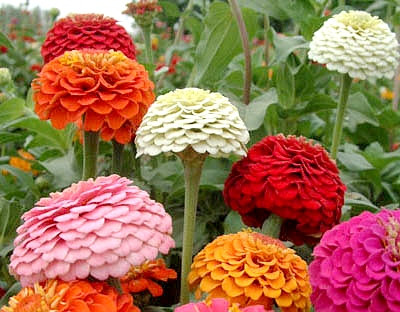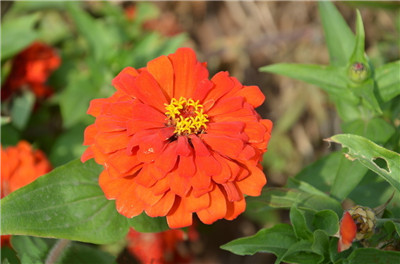How to grow zinnia?
Some flower friends want to raise hundred-day grass, but do not know how to grow it. In this paper, from the point of view of flower friends, starting from the most basic sowing of hundred-day grass, so that flower friends can have a detailed impression of how to plant hundred-day grass. This article is aimed at flower lovers. It is not planted in a large area.
Sowing hundred-day grass
Many flower friends buy zinnia seeds, starting with sowing. Those who buy seedlings directly can skip this step. Zinnia seeds germinate at a suitable temperature of 20-25 degrees, germinate in 7-10 days, and blossom about 70 days after sowing. 2-3 true leaves were transferred and 5 hearts were removed from 4mur. they could be colonized after 2 or 3 times of transplantation. Sowing time-generally speaking, around mid-late April, as long as the temperature meets the germination temperature. When sowing zinnia, be sure to cover a layer of soil, or perlite or vermiculite, because zinnia is a dark flower.
Daily maintenance of Herba Euphorbiae and Zinseng
In order to grow short hundred-day grass, it is necessary to pick the heart many times, leaving 4 leaves to pick the heart at the 6th leaf for a total of 2 or 3 times, and apply potassium hydrogen phosphate after each picking, especially from budding to flowering, spray 0 times every 5-7 days. 2% potassium hydrogen phosphate. Fertilize to prevent disease. After the plant growth is stable, the soil should be kept moist, secondary water should be irrigated in the morning and evening in summer, 200 mg / L nitrogen fertilizer and organic liquid fertilizer should be applied every 5-7 days, compound fertilizer should be used after 2-3 times of application, and thin fertilizer should be applied in the middle of summer.
Second, the daily maintenance of zinzagrass needs to pick the heart many times in order to grow short and hundred-day grass. For the first time, 4 leaves are left to pick the heart for a total of 2 times. Potassium dihydrogen phosphate is applied after each picking, especially from budding to flowering, spraying 0 every 5-7 days. 2% potassium dihydrogen phosphate. Fertilize to prevent disease. After the plant growth is stable, the soil should be kept moist, water should be watered in the morning and evening in summer, 200 mg / L nitrogen fertilizer and organic liquid fertilizer should be applied every 5-7 days at seedling stage, compound fertilizer should be used after 2-3 times of application, and thin fertilizer should be applied in the middle of summer. How to plant zinnia and when to sow
Zinnia is a kind of plant introduced from abroad in our country, which is mainly used as an ornamental. At present, it is distributed in many parts of our country. The flowers of zinnia are more attractive, generally red or white is more common. At present, many people like to plant it, before planting, most of them must want to have a comprehensive understanding of its planting method.
How to plant zinnia
1. Suitable soil. It is necessary to have sandy cultivated soil with humus, fertile, loose and good drainage.
2. Suitable temperature. The suitable temperature for germination is 20 ℃-25 ℃. To ensure that the environmental temperature of sowing is suitable, not too high or too low. Too low temperature will cause the seedlings to grow into "little old seedlings".
3. Sowing method. Zinnia seeds can be sowed on demand or withdrawn, because they are photophobic flower seeds, they must be covered with vermiculite after sowing, and they can germinate in 3 to 5 days at 21: 23 ℃. There is no need for light during the germination period. After germination, the seedling bed should keep 50% of the water content, not too wet, so as to avoid rotting roots or sudden falling disease.
4. Seedling management. After the seedlings of zinnia grow out of a true leaf, the seedlings are transplanted once, the root system of zinnia is undeveloped, and the lateral roots are less. Generally, when transplanting 2 true leaves, it should be planted in a pot, and the transplanting substrate should be loose, fertile and well drained. It can be prepared with 3 parts of pond mud, 1 part of rotten leaf soil and 1 part of mature heap manure, and the planting depth is 0.5 cm under cotyledons. After planting, the soil is lightly pressed and watered.
When will the zinnia be sown?
The sowing time of hundred-day grass depends on the required flowering time, generally sowing in the greenhouse 2-3 months in advance, direct seeding in the open field should be after the severe cold in early spring, otherwise the seedlings are underdeveloped. If the flower bed is used in autumn, it is suitable to sow in summer, spring sowing in March to April, transplanting in 4 to 5 leaves, planting in early June, and flowering from July to Frosts Descent.
How to pick the heart of a hundred-day grass
1. Time. When the clover grows to more than four to six leaves, it needs to pick the heart.
2. Pick the heart for the first time. When the seedlings of zinnia grow to 4 leaves, they should be planted and heart-picked. After about a week of planting, it began to pick the heart. When the seedling height of the hundred-day grass was about 10cm, two pairs of leaves were left, and the rest of the leaves were picked out.
3. Pick the heart for the second time. It is not that the heart is not picked after one time, when the lateral branch grows 2-3 pairs of leaves, the heart is picked for the second time. The solution can be sprayed evenly on the upper leaves of the plant, once every one to two weeks for a total of 2 or 3 times. The number of heart-picking should not be carried out as soon as you want, but whether to carry out the next heart-picking should be decided according to the growth of the plant and the condition of the branches.
How to water the hundred-day grass
1. The control of water quantity. In fact, how to water is really difficult to decide. if there is more water, the root will rot, but it certainly won't work without less water. The editor told you that there is no standard for watering zinnia. We can only decide according to its growth habits and the actual situation.
2. Watering at seedling stage. When choosing the sowing method to plant zinnia, it should be watered as little as possible in its seedling stage, so as to promote the robust growth of its seedlings. After that, you can keep the wettability of the soil between 50% and 60%. Don't be too wet, otherwise it is very easy to have rotten roots.
3. Transplanting and watering more. Be careful when transplanting zinnia, it must be watered enough at this time, so that it can absorb more water and nutrients and ensure its growth.
4. Watering with light. In places where the light is particularly strong, water evaporates very quickly and can be watered in an appropriate amount, but if the zinnia is put in a place where there is not enough light, the rate of soil evaporation will be very slow. at this time, we must reduce watering, if it is still a large amount of watering, it is likely to affect its root system development, leading to its growth.
In fact, it is not difficult to plant zinnia, first of all, choose the right soil, and then choose the right time to sow. In the later stage of planting, it is necessary to strengthen management, and timely coring is beneficial to the growth of zinnia. The control of water quantity is also the key, and the amount of watering varies in different growth periods.
- Prev

The Propagation method of Zinnia
The main propagation methods of zinnia include seed propagation and cutting propagation. Before the propagation and sowing of zinnia seeds, the soil and seeds of zinnia should be strictly disinfected to prevent diseases and insect pests during the growing period. The seeds can be sowed from early April to late June, and the seeds are disinfected and soaked in 1% potassium permanganate solution for 30 minutes.
- Next

The sowing method of zinnia seed
The optimum temperature for seed germination is 20-25 degrees, germinates in 7-10 days, and blossoms about 70 days after sowing. 2-3 true leaves were transferred and 5 hearts were removed from 4mur. they could be colonized after 2 or 3 times of transplantation. In North China, more than half of April was sown in the open field, and about-week sprouted.
Related
- Fuxing push coffee new agricultural production and marketing class: lack of small-scale processing plants
- Jujube rice field leisure farm deep ploughing Yilan for five years to create a space for organic food and play
- Nongyu Farm-A trial of organic papaya for brave women with advanced technology
- Four points for attention in the prevention and control of diseases and insect pests of edible fungi
- How to add nutrient solution to Edible Fungi
- Is there any good way to control edible fungus mites?
- Open Inoculation Technology of Edible Fungi
- Is there any clever way to use fertilizer for edible fungus in winter?
- What agents are used to kill the pathogens of edible fungi in the mushroom shed?
- Rapid drying of Edible Fungi

